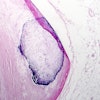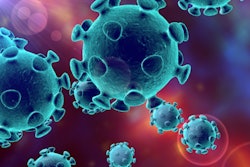
A newly developed artificial intelligence (AI)-based system is highly accurate for detecting the novel coronavirus disease (COVID-19) on thoracic CT studies, according to research published online March 13 on arXiv.org. It can also quantify and track disease burden.
A team of researchers led by Ophir Gozes of software developer RadLogics and Dr. Eliot Siegel of the University of Maryland School of Medicine developed an AI system based on 2D and 3D deep-learning models. Testing on 157 patients from China and the U.S., the system produced an area under the curve (AUC) of 0.996 for differentiating between coronavirus and noncoronavirus.
"Using standard machine-learning techniques and innovative AI applications, in combination with an established pulmonary CT detection platform, an effective tool can be utilized for the screening and early detection of patients who may have contracted the COVID-19 pathogen," the authors wrote. "In individual patients who have contracted the virus and have the pulmonary abnormalities associated with it, the same methodologies can be used to accurately and more rapidly assess disease progression and guide therapy and patient management."
The researchers hypothesized that AI-based tools could be quickly developed for COVID-19 by modifying and adapting existing models and combining them with initial clinical understanding. Their system is designed to analyze thoracic CT images and flag suspected COVID-19 cases for review by radiologists.
In cases that it deems to be positive, the system also automatically generates opacity measurements and provides a slice-based "heat map," as well as a 3D volume display of the opacities throughout the lungs. In addition, it also computes what the researchers call a "corona score," a volumetric measurement of opacity burden.
What's more, the system can enable patient-specific progression of disease monitoring via a "Relative Corona" score, in which the Corona score is normalized by the score computed at the patient's first measured disease time point.
The system utilizes several components, including software from RadLogics for nodule and small opacity detection within a 3D lung volume, a lung segmentation module, and a deep convolutional neural network (CNN) for detecting coronavirus-related abnormalities.
After being pretrained on the ImageNet database, the CNN was trained using suspected COVID-19 cases from several Chinese hospitals. After the successful initial evaluation, the study is now being expanded to a larger population.
The researchers said that rapid evaluation of high volumes of screening or diagnostic thoracic CT studies by an accurate AI software application could be useful for reliably excluding negative CTs. As a result, case volume for the radiologists would therefore be reduced. In addition, the progression and regression of the disease could be monitored more quantitatively and consistently, according to the authors.
"This would allow a greater volume of patients being screened for coronavirus, with earlier and more rapid detection of positive cases, which could lead to more effective identification and containment of early cases," they wrote.
They noted that their paper has also been submitted to Radiology: Artificial Intelligence for possible publication.





















